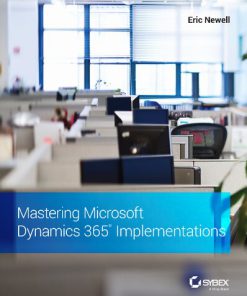Gradle Effective Implementations Guide 2nd Edition by Hubert Klein Ikkink ISBN 1784394971 9781784394974
$50.00 Original price was: $50.00.$25.00Current price is: $25.00.
Gradle Effective Implementations Guide 2nd Edition by Hubert Klein Ikkink – Ebook PDF Instant Download/Delivery: 1784394971 ,9781784394974
Full download Gradle Effective Implementations Guide 2nd Edition after payment

Product details:
ISBN 10: 1784394971
ISBN 13: 9781784394974
Author: Hubert Klein Ikkink
Gradle is a project automation tool that has a wide range of applications. The basic aim of Gradle is to automate a wide variety of tasks performed by software developers, including compiling computer source code to binary code, packaging binary codes, running tests, deploying applications to production systems, and creating documentation. The book will start with the fundamentals of Gradle and introduce you to the tools that will be used in further chapters. You will learn to create and work with Gradle scripts and then see how to use Gradle to build your Java Projects. While building Java application, you will find out about other important topics such as dependency management, publishing artifacts, and integrating the application with other JVM languages such as Scala and Groovy. By the end of this book, you will be able to use Gradle in your daily development. Writing tasks, applying plugins, and creating build logic will be your second nature.
Gradle Effective Implementations Guide 2nd Edition Table of contents:
1. Starting with Gradle
Declarative builds and convention over configuration
Support for Ant Tasks and Maven repositories
Incremental builds
Multi-project builds
Gradle Wrapper
Free and open source
Getting started
Installing Gradle
Installing with SKDMAN!
Writing our first build script
Default Gradle tasks
Task name abbreviation
Executing multiple tasks
Command-line options
Logging options
Changing the build file and directory
Running tasks without execution
Gradle daemon
Profiling
Offline usage
Understanding the Gradle graphical user interface
Task tree
Favorites
Command line
Setup
Summary
2. Creating Gradle Build Scripts
Writing a build script
Defining tasks
Defining actions with the Action interface
Build scripts are Groovy code
Defining dependencies between tasks
Defining dependencies via tasks
Defining dependencies via closures
Setting default tasks
Organizing tasks
Adding a description to tasks
Grouping tasks together
Getting more information about a task
Adding tasks in other ways
Using task rules
Accessing tasks as project properties
Adding additional properties to tasks
Avoiding common pitfalls
Skipping tasks
Using onlyIf predicates
Skipping tasks by throwing StopExecutionException
Enabling and disabling tasks
Skipping from the command line
Skipping tasks that are up to date
Summary
3. Working with Gradle Build Scripts
Working with files
Locating files
Using file collections
Working with file trees
Copying files
Archiving files
Project properties
Defining custom properties in script
Defining properties using an external file
Passing properties via the command line
Defining properties via system properties
Adding properties via environment variables
Using logging
Controlling output
Using the Gradle Wrapper
Creating wrapper scripts
Customizing the Gradle Wrapper
Summary
4. Using Gradle for Java Projects
Why plugins?
Getting started with the Java plugin
Using the Java plugin
Working with source sets
Creating a new source set
Custom configuration
Working with properties
Creating Javadoc documentation
Assembling archives
Summary
5. Dependency Management
Dependency configuration
Repositories
Adding Maven repositories
Adding Ivy repositories
Adding a local directory repository
Defining dependencies
Using external module dependencies
Using project dependencies
Using file dependencies
Using client module dependencies
Using Gradle and Groovy dependencies
Accessing configuration dependencies
Setting dynamic versions
Resolving version conflicts
Adding optional ANT tasks
Using dependency configurations as files
Summary
6. Testing, Building, and Publishing Artifacts
Testing our projects
Using TestNG for testing
Configuring the test process
Determining tests
Logging test output
Changing the test report directory
Running Java applications
Running an application from a project
Running an application as a task
Running an application with the application plugin
Creating a distributable application archive
Publishing artifacts
Uploading our artifacts to a Maven repository
Working with multiple artifacts
Signing artifacts
Packaging Java Enterprise Edition applications
Creating a WAR file
Creating an EAR file
Summary
7. Multi-project Builds
Working with multi-project builds
Executing tasks by project path
Using a flat layout
Ways of defining projects
Filtering projects
Defining task dependencies between projects
Defining configuration dependencies
Working with Java multi-project builds
Using partial builds
Using the Jetty plugin
Summary
8. Mixed Languages
Using the Groovy plugin
Creating documentation with the Groovy plugin
Using the Scala plugin
Creating documentation with the Scala plugin
Summary
9. Maintaining Code Quality
Using the Checkstyle plugin
Using the PMD plugin
Using the FindBugs plugin
Using the JDepend plugin
Using the CodeNarc plugin
Summary
10. Writing Custom Tasks and Plugins
Creating a custom task
Creating a custom task in the build file
Using incremental build support
Creating a task in the project source directory
Writing tests
Creating a task in a standalone project
Creating a custom plugin
Creating a plugin in the build file
Creating a plugin in the project source directory
Testing a plugin
Creating a plugin in a standalone project
Summary
11. Gradle in the Enterprise
Creating a sample project
Using Jenkins
Adding the Gradle plugin
Configuring a Jenkins job
Running the job
Configuring artifacts and test results
Adding Gradle versions
Using JetBrains TeamCity
Creating a project
Running the project
Using Atlassian Bamboo
Defining a plan
Running the build plan
Summary
12. IDE Support
Using the Eclipse plugin
Customizing generated files
Customizing using DSL
Customizing with merge hooks
Customizing with an XML manipulation
Merging configuration
Configuring WTP
Using the IntelliJ IDEA plugin
Customizing file generation
Running Gradle in Eclipse
Installing the buildship plugin
Importing a Gradle project
Running tasks
Running Gradle in IntelliJ IDEA
Installing the plugin
Importing a project
Running tasks
Summary
People also search for Gradle Effective Implementations Guide 2nd Edition:
gradle best practices
gradle implementation examples
gradle implementation keyword
gradle implementation vs api
gradle effective pom
Tags: Hubert Klein Ikkink, Gradle Effective Implementations
You may also like…
Computers - Applications & Software
Mastering Microsoft Dynamics 365 Implementations 1st Edition Eric Newell
Uncategorized
Study Guide for Gould s Pathophysiology for the Health Professions 6th Edition Robert J Hubert
Politics & Philosophy - Cultural
The Communicative Construction of Reality 1st Edition Hubert Knoblauch
Chemistry - Organic Chemistry
Organic Chemistry Student Study Guide and Solutions Manual 4th Edition David R. Klein
Technique - Electronics
Politics & Philosophy - Politics
Chemistry - Organic Chemistry











